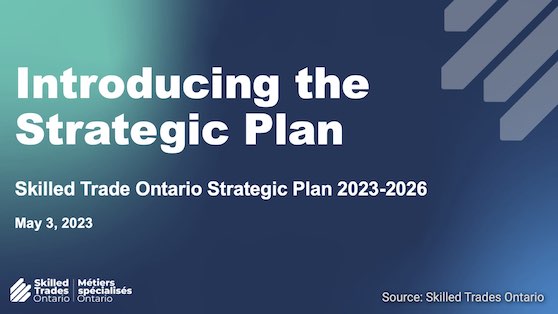
Articles
Business
Features
News
Articles
Blog
Careers
News
Training & Education
Women in Construction
Ontario – the place “where skilled trades professionals thrive”
June 2, 2023 | By Anthony Capkun

June 2, 2023 – To make Ontario “the place where skilled trades professionals thrive”. That’s the overarching vision behind Skilled Trades Ontario’s first Strategic Plan, unveiled by STO’s CEO and registrar, Melissa Young, at the agency’s first-ever industry summit on apprenticeship.
Attended by some 250 industry leaders, educators, and apprentices, the event was divided into morning and afternoon activities. The morning saw speakers from government, Young, and an industry panel.
Monte McNaughton, Ontario’s Minister of Labour, Immigration, Training and Skills Development, delivered a few remarks at the outset, reminding the audience of the government’s 3-step skilled trades plan:
• End the stigma
• Modernize the system
• Encourage employers to take on apprentices
“We are making progress,” McNaughton said.
Charmaine A. Williams, Associate Minister of Women’s Social and Economic Opportunity, noted that when it comes to women and skilled trades, retention remains a huge issue. She said 50% of women leave their skilled trade after four years: “They are not feeling safe on jobsites”.
Williams is pleased to see woman-friendly PPE on the market, and hopes better jobsite washrooms become ubiquitous across the province. She also said the government is investigating how they could have daycares open earlier (and make them cheaper) so that having children isn’t a barrier to women entering the skilled trades.
Keynote speaker Dan Mills, New Brunswick’s Deputy Minister of the Department of Post-Secondary Education, Training and Labour, noted Canada’s average apprentice pass rate is 51%, while New Brunswick’s pass rate is in the 70 percentile. “Our system seems to be working,” he noted.
Through anecdotes and advice, Mills pointed to the importance of a robust skilled trades system that goes the extra mile for its apprentices and helps see them through to completion. After all, lower birth rates are the norm in both Canada and globally, which means every sector will have to work harder to attract and retain workers.
Mills told attendees about Jeremy: a Level 3 instrumentation tech who couldn’t find a placement to complete his Level 4 (there weren’t enough students, so it was cut). Mills conducted exhaustive search in neighbouring Maritime provinces, but to no avail, because their programs for instrumentation tech were too dissimilar. Same with Ontario, Manitoba and Saskatchewan.
It wasn’t until he got to Alberta that they found a placement for Jeremy because the programs were similar.
Not only is this story a great example of going that extra mile, but it also highlights how greater harmonization across provinces could help more apprentices cross the finish line.
Mills asked attendees to consider how they could help apprentices who are struggling. Rather than write them off, talk to them; maybe that apprentice has a learning disability that could be easily addressed.
He recounted a story about a welding apprentice who simply could not pass his Level 2, no matter what… yet he was a fantastic TIG welder. So why was he failing?
After some investigation, the apprentice was given graph paper to use as a scratchpad the next time he sat down to write his Level 2 exam. A simple thing like this helped the apprentice organize his thoughts and go on to pass his Level 2.
Capping off the morning session, EBMag’s Anthony Capkun moderated a panel of employers, educators and apprentices to get their gut reactions to STO’s Strategic Plan. The panel included:
• Nick Dewar – Trained as a sheet metal worker, now general manager with Optimum Mechanical.
• Kylia Mulvee – Starting her apprenticeship for electrical.
• Paiton Manuel – A second-year brick and stone masonry apprentice.
• Alan McClelland – chair, Heads of Apprenticeship Training Committee, Colleges Ontario; Dean, School of Transportation, Centennial College.
• James St. John – Trained as ironworker, now business manager/financial secretary of the Central Ontario Building Trades, and president/director of the Hammer Heads Program.
• Robert De Rubeis – 35 years in secondary and post-secondary education, now manager of Gateway to the Trades.
All panelists felt the vision presented in the Strategic Plan was on the money, with one word of caution: the devil is in the details.
After lunch, attendees participated in a facilitated workshop—“Building STO’s future”—to foster discussion and generate ideas toward making STO’s vision come alive. That vision is underpinned by these four objectives:
#1 – Support an innovative apprenticeship and certification model
Support an apprenticeship experience that prioritizes the needs of Skilled Trade Ontario’s clients, and support employers in building the skills and capabilities of their apprentices.
#2 – Promote and advance the skilled trades
Promote and advance the skilled trades to ensure the skilled trades workforce is robust and trained to the highest standard, and that skilled trades professionals can take pride in their career choice and the services they provide.
#3 – Facilitate research in the skilled trades
Take an informed, data-driven approach to decision-making to improve operational efficiency, customer satisfaction, and the overall performance of the skilled trades sector.
#4 – Build a diverse, equitable, and inclusive skilled trades sector
Create a welcoming environment that fosters creativity and encourages teamwork, and empower individuals from all backgrounds by promoting equity and inclusion in the skilled trades.
“The labour shortage is a critical challenge for Ontario, and it is more pressing now than ever before,” said Young. “With one in five jobs predicted to be in the skilled trades by 2026, we need to take action to attract and inspire the next generation of skilled trades professionals. Our strategic plan will provide a clear roadmap for driving growth in the sector and positioning Ontario as a leader in apprenticeship.”
You’ll find all Back Issues of Electrical Business Magazine in our Digital Archive.
Print this page
